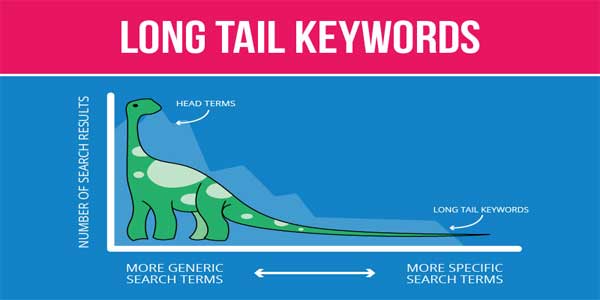
Keywords have always played an important role in SEO. But whereas in the early days, websites would simply cram in as many keywords as they could to rank in the search engines, things have changed a lot since then.
One of the big questions many people new to SEO ask is whether they should be targeting long-tail keywords or not. Here’s a guide to what these are, why you should target them, and how you should go about doing so.
Table of Contents
What Are Long-Tail Keywords?
Long-tail keywords are essentially just longer keywords. While a “head” keyword may be one or two words (e.g. “travel insurance”), a long-tail keyword usually consists of four keywords or more (e.g. “where can I buy travel insurance”).
Long-tail keywords often (but not always) use head keywords within them, as in the example above.
Why Do They Matter?
Long-tail keywords matter for a number of reasons. For a start, they tend to be less competitive, making them easier to rank for—which is especially useful for businesses that are just starting out with their SEO.
They are also more specific, meaning the traffic they generate is more targeted. This can help to increase conversions.
You can also target a lot of them. There are many long-tail keywords for every head keyword, giving you more chance to rank your content for a variety of keywords and get more traffic as a result.
The way we search is also changing. Because of voice search on cell phones, many people are now asking questions directly into their phones, and these tend to be longer queries using long-tail keywords.
How to Find Suitable Long-Tail Keywords?
First of all, you need to find these long-tail keywords, and you can use tools to do this, such as this keyword planner tool, which will get you off to a great start.
But you can also simply use Google search to start generating ideas. Type in a query, and at the end of the results page you will see a list of related searches.
Many of these will be long-tail keywords, and they are also searches that have already been made, so you know people are searching for them. You have no data on them, but they can be great for brainstorming.
You can also use Google’s suggest feature in search. Start typing in a search and see what Google suggests, and again these are real searches that have already been made before.
Google’s Keyword Planner is another useful tool. This is free to use, and it provides you with data on the number of searches and gives you an idea of how competitive they are.
Use a selection of tools to find a good collection of long-tail keywords, then add them to a spreadsheet. Also add any data you find alongside them, like the number of monthly searches.

How to Use Long-Tail Keywords?
To use the keywords you have found, start by organizing them by category. If you have different categories of products or services, separate the keywords out into different groups.
While you can and should use long-tail keywords in your main website product and service pages, the real benefit of these keywords comes when you use them in blog posts.
How you use them depends on the amount of content you can produce, but one tactic is becoming increasingly popular.
This involves creating a large authoritative guide on a topic related to one of your services. Aim to make it 3,000 words or more because Google loves long, authority content, and you can turn it into a real resource to make it easier to build links and get more shares.
Then look through your list of long-tail keywords related to the topic, and create different sections of the guide based around each relevant keyword. This allows you to use multiple keywords in the content naturally.
The aim is that you can then start ranking this content for multiple long-tail keywords. You can then share it on social media and reach out to bloggers to get links. If it’s better than the other content on the topic, you should be able to get some backlinks and start ranking it.
Alternatively, you could create a larger number of shorter blogs, each one focusing on one or two related long-tail keywords. The more of these you publish, the more pages and keywords you can rank for. But you will still have to build links to each blog, which may be harder if they are shorter and less authoritative.
Boost Your Rankings with Long-Tail Keywords:
Long-tail keywords are more important than ever, so make sure you are using them in your own SEO strategy. They are especially important if you are just starting out and you want to rank your website for relevant keywords sooner.
So start working on your long-tail keyword strategy, find a list of keywords to target, then create content around them to start ranking your web pages in the search engines.


















Useful Post…Thank you for sharing
Welcome here and thanks for reading our article and sharing your view.
Thanks for sharing, usefull info.
It takes some time to find the right keywords!
Welcome here and thanks for reading our article and sharing your view.